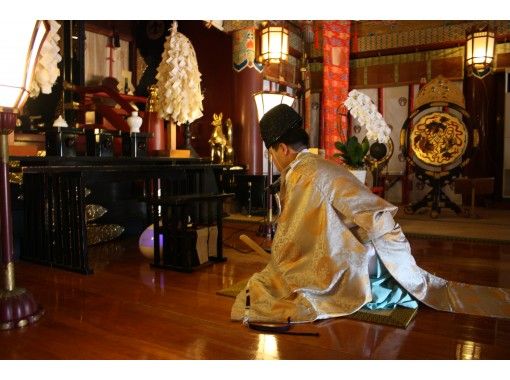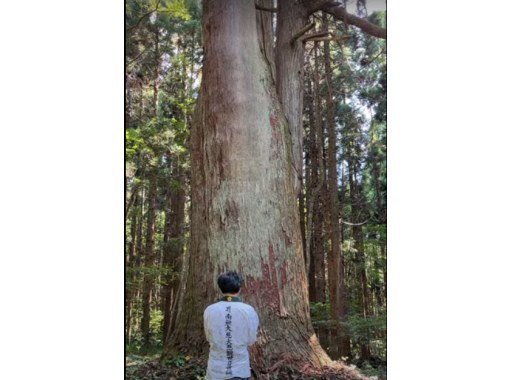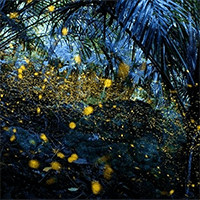- Age 8~Age 90
- 1~2 hours
- 11:30 / 13:35 / 15:40 / 18:30
スズ板から木づちと木の型を使って小皿を作っていくプランです。金属の中でもスズは比較的やわらかく、加工しやすい素材といわれるので、はじめて鍛金に挑戦する人や力に自信がない人におすすめです。頑張れば、浅めのぐいのみにすることもできます! 一見でこぼこな打ち跡を整えて、表面がなめらかに仕上がれば完成です。 * Courses may not be held due to unexpected events (natural disasters such as typhoons, sudden illness of instructors) etc. In that case, we will contact you by phone, e-mail etc before noon of the day. Please acknowledge it beforehand.
- Age 10~Age 90
- 1~2 hours
- 09:00
In this plan, you will be able to enjoy the performance of congratulatory words by the priesthood, the shrine maiden dance, and the Kagura drums in the Kagura hall. You will also experience Tamagushi worship. * This plan is not baptism. It is a prayer for your own health and a ritual to cleanse yourself. Comes with an English pamphlet. (We will pray at the same seat as ordinary worshipers who receive normal prayers.) * The priest will perform the above Shinto ritual at the Kagura-den together with the general public, so the waiting time is up to 30 minutes due to circumstances. It may occur to some extent.
- Age 6~Age 100
- Within 1 hour
- 10:00 / 13:00 / 18:00
Why don't you try to create a work with a long-awaited electric wheel? You can reserve 1 to 6 people. Although it is difficult for beginners, electric instructors are well supported by experienced teachers. It is Ichiban to try actually to have the real pleasure of the pottery. Please try it by all means!
- Age 12~Age 100
- 1~2 hours
- 10:00 / 12:00 / 14:00
This is a hands-on class for foreign visitors to Japan to experience the traditional Japanese culture of calligraphy. Located in Jimbocho, the town of second-hand books, this calligraphy class is supported by leading instructors who will help you have a memorable experience of Japanese culture, calligraphy. We will assign kanji to your name and prepare a sample in advance. First, while grinding the ink, the instructor will explain the calligraphy tools, how to sit, how to hold and use the brush, etc. You will be carefully taught how to write the kanji for your name, your favorite characters, or the words you want to write, and at the end, you will finish it into a colored paper or fan to take home as a souvenir. All tools will be provided. Please feel free to join us empty-handed.
- Age 12~Age 65
- 1~2 hours
- 10:00 / 13:00
The owner travels to coffee-producing regions around the world and carefully selects coffee beans that are thoroughly managed from cultivation to harvesting and transportation! In order to enjoy high-quality coffee with a rich original flavor called "specialty coffee," he roasts and brews the beans himself. The flavor changes drastically depending on the strength of the roast and the time, so adjust the roasting level to match your favorite flavor and aroma. Experience the profound world of coffee. A place in the Shitoori district of Minami Awaji City, where idyllic rural scenery spreads out. After getting off the car, walk for two minutes along a country road surrounded by trees to the Awaji Island Coffee Laboratory "BASE COFFEE," an annex to the premises of "Fuku Cafe," a quiet, hidden old-style cafe. If a cafe is a hideaway, this laboratory has the atmosphere of a "secret base." The owner, who is obsessed with the depth and unanswerable charm of coffee, is researching and studying every day to get to know coffee better and to pursue the creation of "coffee that makes you want to talk about it with others and makes you smile". The owner carefully selects coffee beans from producing areas around the world, including Central and South America, Africa, and Asia, and thoroughly manages the process from cultivation to harvesting and transportation. Using these top quality beans, you will experience roasting, the most important process that determines the taste and aroma of coffee. For the roasting process, we use a roasting pan called "mankashakasha", which is actually used in Ethiopia, one of the countries where we purchase beans. You can choose to roast lightly to bring out the fruity aroma and acidity of citrus fruits, or roast deeply to bring out the richness and bitterness of chocolate, or you can aim for something in between. In either case, it is difficult to conduct heat thoroughly to the inside of the raw beans in order to remove the moisture contained in them. In addition, even if you choose the same beans and roast in a hand pan, the heat transfer changes depending on how the beans roll and how the wind hits them, so even if the conditions are slightly different, the taste will not be the same and an original taste will be created. The staff will give you a thorough lecture, so please feel free to try it. When the roasted beans are cooled and ground in a coffee mill, a scent containing various elements, including the scent of nuts, caramel, and citrus, rises. This is the moment when the coffee beans emit the most aroma in their life. There are hundreds of elements of the aroma, which becomes a complex and rich coffee aroma that fascinates many people. Then comes the finishing process. Hot water is poured over the fragrant freshly ground beans to extract the maximum aroma and flavor, but there is also an appropriate way to pour the hot water. When you put the carefully extracted coffee in your mouth, your face will naturally break into a smile. *One cup of roasted and ground beans will be used for tasting, but you can take the remaining beans home with you.
- Age 13~Age 99
- 1~2 hours
- 14:00
Welcome to Tokyo, Japan!If you have chance to come to Tokyo, not only enjoying sightseeing, but we recommend you try one of Japanese traditional artistic activities.Join us making delicious and beautiful "Wagashi", traditional Japanese sweets.Different from workshop at a room in an apartment, you can experience real genuine one at a small, quaint, local, real Mochi shop in Shinjuku, led by a Japanese Wagashi artisan.For this reason, many national and international celebrities have also become our customers.You will be making some pieces of seasonally inspired "Nerikiri", a kind of Wagashi made of sweet white bean paste and MOCHI.First, watch closely and learn while we demonstrate how to make Wagashi, then it's your turn to try your hand at Wagashi making. Delicately form the colored dough into various shapes by hand and carefully add lines with tools to perfectly portray "the seasonal beauty of Japan".Even if you have little experience in creative activities or cooking, we will carefully guide you through the process.
- Age 15~Age 90
- 1~2 hours
- 14:30 / 16:00
You will learn how to make a mizuhiki band and how to tie a flat plum knot, and decorate a gift envelope. You can take home the gift bag you made. komorebi This is the contents of Mizuhiki course C2. ~ Flow of the day ~ ① Seating, explanation (5 minutes) ② Kit confirmation (10 minutes) ③ Production (45 minutes) ④ Wrapping and cleaning up (5 minutes)
- Age 6~Age 80
- 1~2 hours
- 10:20 / 14:20
You can experience making traditional Japanese food "onigiri" in Ariake, Tokyo. While the rice is cooking, prepare the onigiri ingredients: shrimp tempura, grilled salmon, pickled plum, tuna, and edamame. After boiling and sterilizing the onigiri mold and spatula, make the onigiri. You will make five onigiri while being shown the key points of how to make them. You can enjoy two of the finished onigiri on the spot while looking at the view of Tokyo Bay. You can take the rest home. You can take the tools you used, such as the mold and spatula, home as a souvenir! 10% of the fee we received this time will be donated to organizations such as the Red Cross. You can learn about Japanese soul food in a fun and delicious way, and make a donation in hopes of world peace. This is a special workshop that only Seiko, a designer and onigiri evangelist who is active worldwide, can offer. ~Dietary therapy~: Cure mental and physical disorders with food. It is a phrase that has been said in Japan since ancient times for maintaining health. ~Experience Flow~10:10 MeetMeet in front of the main entrance of Brillia Mare Ariake. 10:10 Wash your hands and prepareWe will explain the flow of the experience and prepare your hands. 10:10 Prepare ingredients such as shrimp tempura musubi10:30 Make rice balls. Use an onigiri mold to make five rice balls. 11:20 Tasting TimePlease try the finished rice balls while looking at the view. 14:10 MeetMeet in front of the main entrance of Brillia Mare Ariake. 14:10 Wash your hands and prepareWe will explain the flow of the experience and prepare your hands. 14:10 Prepare ingredients such as shrimp tempura musubi14:30 Make rice balls. Use an onigiri mold to make five rice balls. 15:20 Tasting TimePlease try the finished rice balls while looking at the view.
当我们到达33楼一个明亮的开放式厨房时,Seiko已经为我们准备好了一切,桌面上准备了中英文教程,其中中文教程还是手写的。感谢Seiko的细致和热心。 在Seiko的精心指导下,我们做了几款不同馅料的日式饭团。我们非常享受整个制作过程。和Kat的交谈中,我们还知道了Seiko同时是一位知名的日式花艺创作人,一直在为推广日本传统文化付出努力。 我们可以看到东京的天际线,这里风景绝佳。 在33楼的大露台上,天空飘下了2025年的第一场雪,我们隔着窗看着星星点点的白雪花。 体验了美食,同时感受了特别的日本文化。不同寻常的一天。
- Age 7~Age 80
- 2~3 hours
- 09:30 / 13:30
Place the shiroba glaze of your favorite color on the copperplate and bake it and make original accessories and accessories. ~ Flow of the day ~ ① Decide on the work to be assembled (15 minutes) ② Demonstration and experience (100 minutes)
七宝焼を体験したくて、探して行きました。 初歩的な事から丁寧に教えてくださり、素敵なブローチを作ることが出来ました。 終わった後は、コーヒーも入れてくださりホッと一息。楽しい時間をすごす事ができました。 ありがとうございました!
- Age 2~Age 80
- 1~2 hours
- 14:00 / 16:00 / 19:30
3 minutes walk from JR Omori Station, Tokyo①A calligraphy experience class will be held in the grounds of Omori Sanno Hie Shrine. In an ancient Japanese-style room, you can write kanji and kana using real brushes, Japanese paper, ink, and inkstones. All tools will be provided here, so please come empty-handed. You can take home the work you have written (if you wish, we will provide a frame and a seal). The instructor is a Bunka Calligraphy Higher Master and also teaches at several calligraphy classes in Tokyo. ②On the second floor of the same building, we hold lessons for the Iwama-ryu Aikido class, and if the time is right, you can also observe and experience it. In addition to physical techniques, there are also weapon techniques (using swords, canes, and daggers). ③In addition, simple tea utensils will be provided upon request, so you can experience the tea ceremony by making your own matcha. ④Nearby is Omori Shell Mound Park, where you can take a stroll and feel the Jomon period. Since it is not a famous Japanese landmark, you can quietly experience Japanese culture in a hidden sacred place that only those in the know know about. Valuable photo opportunities and videos are sure to become fond memories of your trip. *Experiences and messaging will be available in Japanese and English only.
- Age 10~Age 50
- 3~4 hours
- 10:00
"Enjoy the scenery of the UNESCO World Heritage Shirakami-Sanchi" Walk the mountains of Noshiro in full pilgrimage attire with Noen Haruharu, a guide from Ryusenji Temple! You can hear about history and faith from your guide, and about trees and flowers from Noen Haruharu. Experience Buddhism by walking through the mountain scenery of the four seasons. Pick seasonal wild vegetables, cook them yourself, and eat them. Enjoy seasonal wild vegetables with rice balls, pickles, and miso soup. At the end, there is a 15-minute Buddhist talk in English. ~Experience flow~ 9:00 Mountain hiking Content changes depending on the season Pick wild vegetables Take a break at the peak and drink Noen Haruharu's herbal tea Heart Sutra reading in the hall (reading sutras together) 12:00 Return to Ryusenji Temple Cook wild vegetables yourself Don't worry, we will prepare extra if there is not much to pick. Lunch is rice balls with wild vegetables, miso soup, and smoked daikon radish while looking at the Shirakami Mountains. You can listen to a 15-minute talk on Buddhism in English from the head priest. Until 13:00 Q&A We will answer any questions you may have.
最近チェックしたプラン
Please wait a moment
![You can also enjoy cherry blossom viewing! Let's make a small cherry blossom plate! [Tokyo, Otsuka] Artis' creative course - Make a "tin small plate" using hammering techniques! OK in Englishの画像](https://img.activityjapan.com/10/56973/10000005697301_mzjvTiWk_3.jpg?version=1732619042)

![[Aichi/Nagoya] Lecturer will support you! Experience pottery with a longing-for electric wheelの画像](https://img.activityjapan.com/10/11956/10000001195601_1GbQxjXH_3.jpg?version=1571372788)
![[Tokyo, Jimbocho] Experience the traditional Japanese culture of calligraphy in a relaxing space surrounded by the scent of ink. Grind the ink and write with a brush to take home as a souvenir! Comes with a free brush pen!の画像](https://img.activityjapan.com/10/55206/10000005520601_1IgGyMt8_3.JPG?version=1720073294)
![[Hyogo, Minami Awaji] Experience roasting coffee beans at a traditional Japanese cafe, grind freshly roasted beans and sample "specialty coffee" and enjoy your own timeの画像](https://img.activityjapan.com/10/58498/10000005849801_1Gz5AIDf_3.png?version=1743402664)
![[Shinjuku-ku] Genuine Wagashi Experience By the Maestro At His Mochi Shの画像](https://img.activityjapan.com/10/52551/10000005255101_3L1iO7Mk_3.png?version=1705665556)
![[Tokyo/Harajuku] For those who have learned the Awaji knotの画像](https://img.activityjapan.com/10/44236/10000004423601_9fYrXSou_3.png?version=1663641757)
![[Tokyo, Ariake] Experience making "Omusubi"! Enjoy traditional Japanese foodの画像](https://img.activityjapan.com/10/53127/10000005312701_XpoMLrj8_3.jpeg?version=1748762704)
![[Chiba Yachimata] Let's make original accessories and accessories! Cloisonne pottery experience planの画像](https://img.activityjapan.com/10/20708/10000002070801_3QB7qHov_3.jpg?version=1715311323)
![[Tokyo, Omori] Calligraphy experience class = You can write kanji and kana with real brushes, Japanese paper, ink, and inkstones in a Japanese-style room in the shrine grounds (You can also visit and experience Aikido, experience tea ceremony, and stroll around the Jomon ruins park)の画像](https://img.activityjapan.com/10/56559/10000005655901_AVWlGGNt_3.jpg?version=1730124002)








